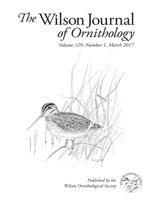Soft-part coloration can be a useful method for determining the age of a bird. For example, hatch-year and early second-year Mangrove Cuckoos (Coccyzus minor) are supposedly distinguishable from older birds based on the presence of a dusky gray eye-ring; individuals gain a vivid yellow eye-ring in their second year of life that they retain for the rest of adulthood. However, observational data collected on banded Mangrove Cuckoos throughout the year indicate that eye-ring coloration varies seasonally rather than with age. We captured and banded two individuals in early spring, each with a yellow eye-ring. Re-sightings of these individuals later in the spring and early summer revealed that the eye-ring had changed to a dusky gray color. Subsequent re-sightings of these individuals again in the fall and winter revealed that both once again had a yellow eye ring. In reviewing photographs and notes taken during observation of marked and unmarked individuals, we determined that this pattern—a yellow eye-ring during late summer, fall, and winter (nonbreeding) and a dusky-gray eye-ring during spring and early summer (breeding)—was consistent across individuals in the population in Florida that we studied.
How to translate text using browser tools
1 March 2017
Eye-ring coloration is not a reliable indicator for aging Mangrove Cuckoos (Coccyzus minor)
Rachel D. Frieze,
John D. Lloyd
ACCESS THE FULL ARTICLE
age determination
bare-part coloration
Coccyzus minor
Mangrove Cuckoo
soft-part coloration





